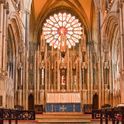The rise and rise of the “nones”
If you are reading this you are part of a generation that is living through a profound cultural shift. You were born in a country in which “Christian” was the majority affiliation, but will die in one in which that is no longer true: for those who say they have “no religion” are now the majority in Britain.The growth of no religion has been almost entirely at the expense of Christianity and the churches in Britain, particularly the largest ones: the Church of England, Church of Scotland and Roman Catholic Church.
The white British population, most of whom would once have identified with a church, are now just as likely to identify with no religion. Once a cultural majority becomes the norm, being part of it becomes a matter of default—it’s opting for something different that requires choice. The default used to be Christianity; now it’s no religion.
When I first carried out a nationally representative survey of British beliefs and values in January 2013, 37 per cent of the population reported having no religion. By February last year that had risen to 42 per cent, and in a survey carried out just 10 months later in late December, the proportion had risen to 46 per cent —a majority of white Britons. If you include those who prefer not to state what their beliefs are, that’s half the total population.
I’m not the only person to have discovered this. The latest British Social Attitudes Survey (2013) found 51 per cent of the total adult population reporting no religion, a rise of two-thirds over a 30-year period. The census reports a similarly swift rise, but a smaller overall proportion of “nones”—those who say they have no religion. One reason for this apparent under-counting may be that heads of household usually fill in census forms on behalf of their children, and may impute an identity to them they don’t actually share.
Younger people are more likely to be “nones.” Among those over the age of 40, the norm is to have a religion: 54 per cent Christian, 40 per cent no religion. Among those under 40, the norm is to have none: 56 per cent no religion, 31 per cent Christian.
Some “nones” pray
This shift can’t be read as a straightforward fulfilment of predictions of inevitable secularisation. Not all “nones” are secular; some look rather religious.Thus one in six of those who say they have no religion believe in God or a higher power, and a quarter take part in some spiritual activity—such as prayer—in the course of a month. Only a small proportion are hostile to religion or identify as secular or humanist (fewer than one in 10). Richard Dawkins, the atheist scientist, is not a typical “none.”
Overall, “nones” are a diverse bunch and, almost by definition, are people who don’t like to be pigeonholed. Nevertheless, my surveys show that they have at least two things in common. First, they are overwhelmingly white British and British-born—93 per cent on the census compared to the national figure of 86 per cent. Second, they are very liberal in their attitudes to personal morality. Like John Stuart Mill, they believe it’s up to individuals to decide for themselves how to live their own lives. They support gay marriage and the current law on abortion, and oppose the blanket ban on assisted dying. They are more liberal than the general population, a little more liberal than Christians (who are very liberal, too, on average), and a lot more liberal than religious leaders such as bishops and chief rabbis.
Have British people become less religious, or has religion become more unattractive?
One thing “nones” really don’t like is organised religion or its traditional leaders. Only 1 per cent are part of an organised religious group, none take guidance from religious leaders, and the only ones they have any time for are Archbishop Desmond Tutu and the Dalai Lama. They are less keen on Pope Francis than Christians of whatever denomination. As just noted, they find much religious teaching illiberal.This suggests that the traditional explanation for religious decline—that people become less religious—may be the wrong way of looking at it. Perhaps it’s religion which has changed the most, leaving people behind.
A survey recently carried out (see the pie charts above) sheds some interesting light on this. Instead of asking people what their religion is, it asked how religious they are. Hardly anyone says they are “very religious,” and not many people even admit to being “religious.” Most say they are “not religious”—and this hardly varies by age. Older people are just as “not religious” as younger ones.
Historical studies and common sense suggest that most people were never very religious, but until quite recently it was fine to be a “cultural” or “ethnic” Christian. “I’m not religious, I’m C of E,” was something I often used to hear when interviewing older people. A former Archbishop of Canterbury’s wife once said that too much religion made her go pop—that’s something you are unlikely to hear these days.
Churches and clergy have become more demanding of their “followers,” and a lot less tolerant of cultural Christians than they once were. Since the 1970s they have resisted changes like remarriage after divorce, the ordination of women and same-sex marriage. Add to that the scandals over the handling of clerical child abuse and the rise of Islamism and religious violence, and it’s clear why many younger people now find religion a toxic brand rather than part of the cultural waters in which they swim.
A growing values gap has opened up between religion and culture since the 1970s, and is an important factor in the rise of “no religion.”










